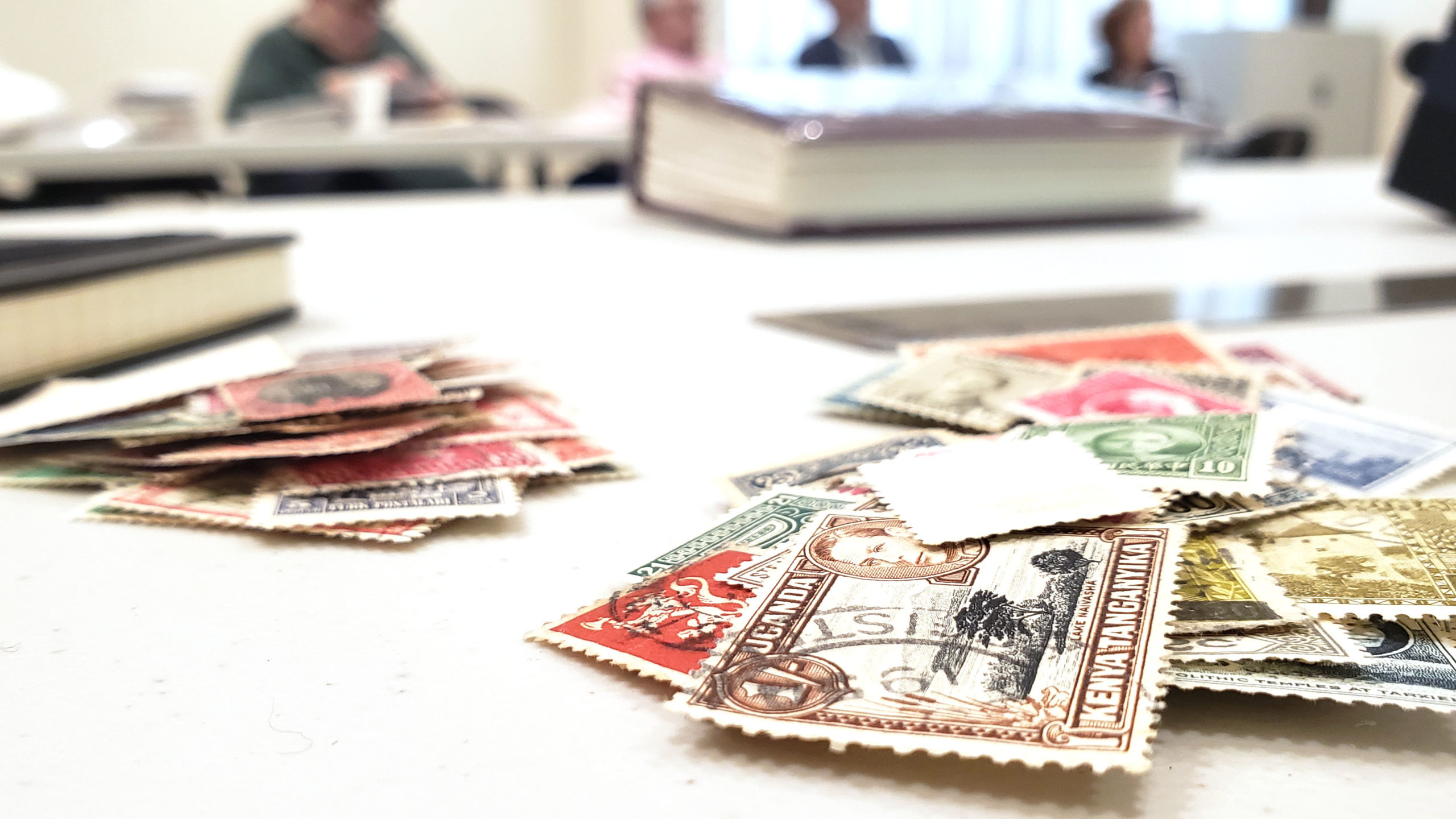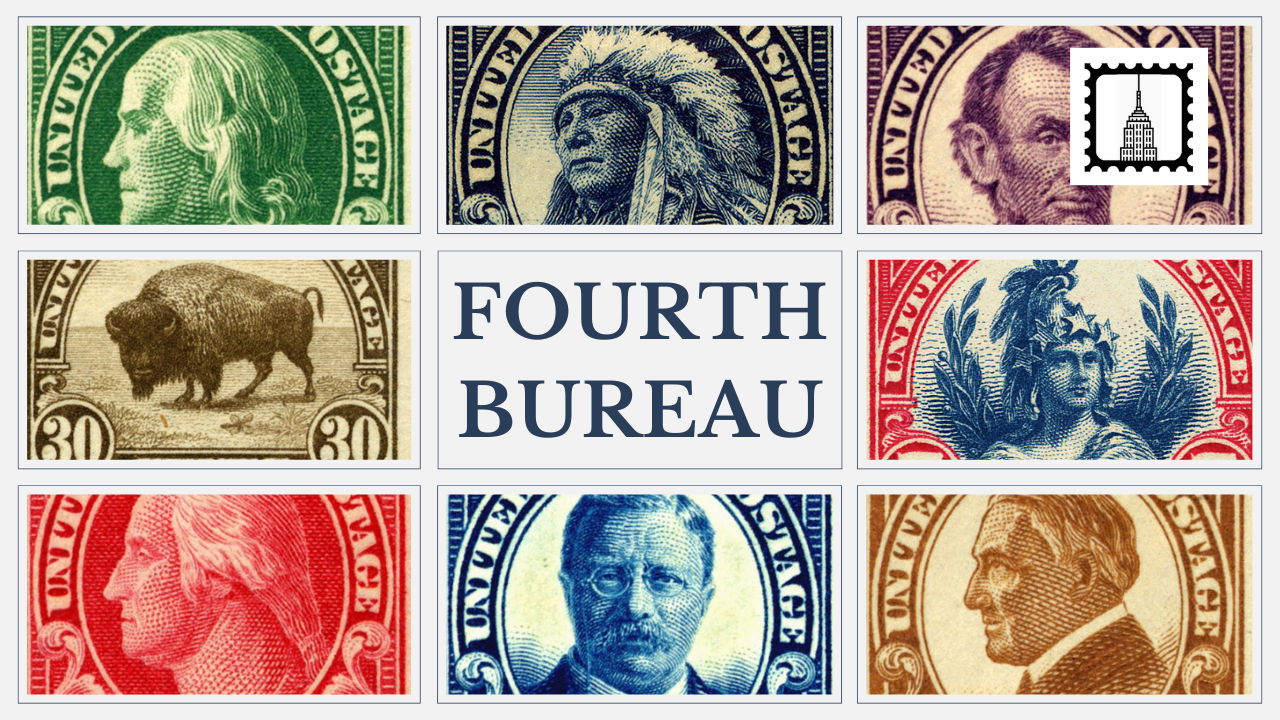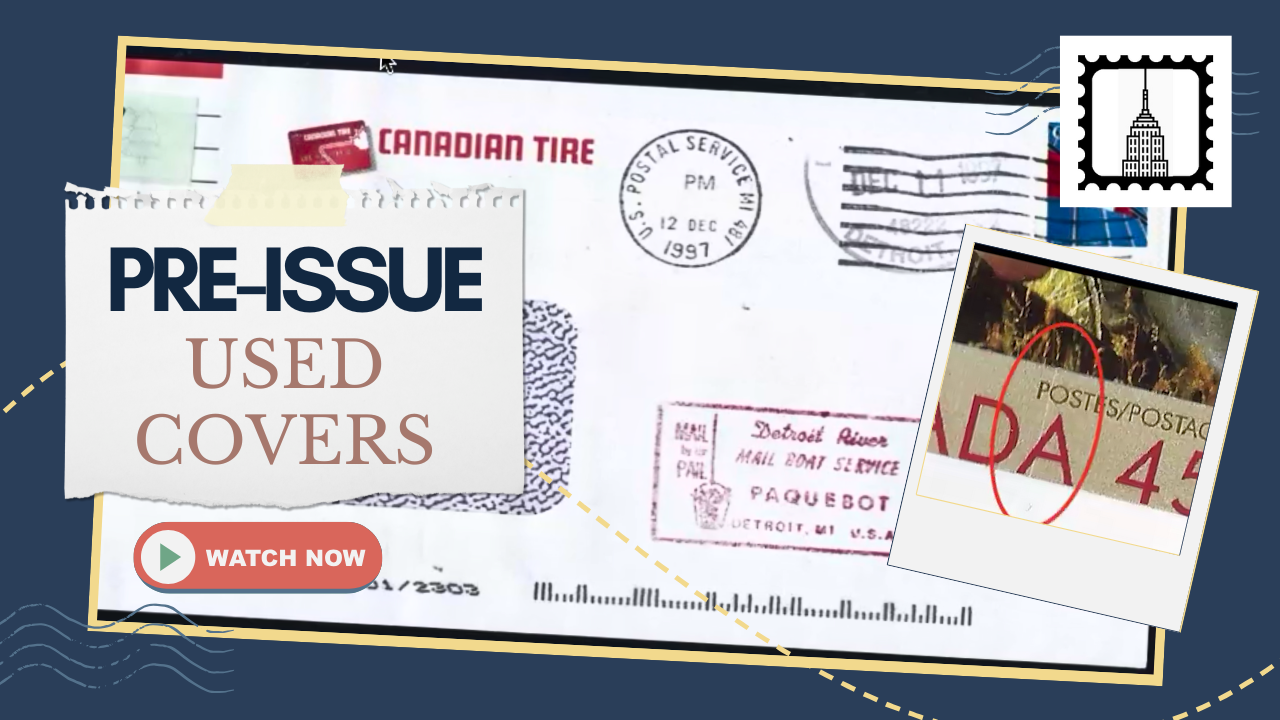Why the Fourth Bureau Issue Is So Complex
Presentation By: Tara Stewart
The Fourth Bureau Definitive Issue (often just called the “Fourth Bureau” or the “Regular Issue”) covers a series of U.S. stamps printed by the Bureau of Engraving and Printing (BEP) from 1922 to 1930. At first glance, many of these stamps share the same portrait or vignette: Ben Franklin, George Washington, Abraham Lincoln, and others. But behind those familiar images lurk countless variations created by:
- Innovations in Printing Methods: Flat plate vs. rotary presses.
- Changes in Perforations: Different gauges or mixed perforations on one stamp.
- Varying Paper Stocks: Special grain directions, leftover “waste” stock, different shrinkage.
- Gum Experiments: Gum breaks and formulations to reduce curling.
- Social and Economic Factors: Rising postage rates, new half-cent denominations, or special overprints like Kansas-Nebraska.
Each of these subtle changes can transform an “ordinary” stamp into a highly sought-after rarity. Below, I’ll discuss the key terms and concepts to help you navigate this wonderful but intricate collecting area.
Understanding the Social, Cultural, Economic, and Technological Context
To fully grasp why these variations exist, it helps to know what was happening in the 1920s:
- Rapid Industrial Growth: New machinery and processes made printing faster and cheaper, pushing the BEP to experiment with rotary presses.
- Changing Postal Rates: Half-cent and one-and-a-half-cent stamps sprang up to handle commercial mail and newly introduced fractional postage needs.
- Cultural Shifts: People revered past presidents and historical figures, but certain individuals (like Hollow Horn Bear on the “American Indian” stamp) weren’t always treated respectfully—reflected in how their names or titles appeared on stamps.
- Economic Pressures: Overprints like “Kans.” and “Nebr.” aimed to cut theft and administrative costs but ended up short-lived.
All these factors helped shape how the BEP created stamps, leading to the many subtle variations we now chase as collectors.
Key Technical Terms and Concepts
Below is a comprehensive list of terms (and why they matter) when collecting the Fourth Bureau Issue.
1. Flat Plate Printing
- What It Is: The traditional process where a flat metal plate is hand-inked, wiped, and pressed onto dampened sheets of paper.
- Why It Matters: Flat plate stamps usually have less distortion in their design. They’re often smaller in height or width compared to rotary-printed stamps.
- Typical Dimensions for Vertically Printed Portraits:
- 19¼ × 22¼ mm (Flat Plate)
2. Rotary Press Printing
- What It Is: A continuous process where curved plates wrap around a cylinder, printing stamps on long “webs” (rolls) of paper.
- Why It Matters: Curving the plate stretches the stamp design, making it taller (endwise coils) or wider (sidewise coils).
- Typical Dimensions for Vertically Printed Portraits:
- 19¾ × 22¼ mm (Sidewise Rotary) – Wider stamps
- 19¼ × 22½ mm (Endwise Rotary) – Taller stamps
3. Sidewise Coils
- Definition: Rotary-printed coil stamps that are perforated so that stamps align side by side in a roll.
- Key Trait: The design gets stretched along the horizontal axis, making the stamp slightly wider.
- Why It’s Important: Sidewise coils can signal valuable rotary-printed variants for certain denominations.
4. Endwise Coils
- Definition: Rotary-printed coil stamps perforated so that stamps align end to end in a roll.
- Key Trait: The design is stretched along the vertical axis, making the stamp slightly taller.
- Why It’s Important: Another hallmark of certain rotary coil issues that are distinct from flat plate stamps.
5. Offset
- Definition: Ink that accidentally transfers to the back of the sheet above or below when stacked during flat plate printing.
- Why It’s Important: Offset ink on the back can be a clue that your stamp was printed via flat plate (especially if it’s older U.S. material from this era).
6. Web of Paper
- Definition: The continuous roll of paper used in rotary press printing, referred to as the “web.”
- Why It’s Important: This shift from sheet-fed printing to web-fed printing in the 1920s was a big leap in postal production efficiency and a major cause of new stamp varieties.
7. Paper Shrinkage
- Definition: Paper expands when dampened and contracts when it dries, shrinking more across the grain than with the grain.
- Why It’s Important: The difference in grain direction can alter the final stamp dimensions. “Special paper” with different grain orientation is a known variety in Fourth Bureau stamps.
8. Master Dies
- Definition: Original engravings in softened steel from which all subsequent copies of a stamp’s design are derived.
- Why It’s Important: Each stamp design starts with a single “master die.” Transfer rolls replicate the master die onto a printing plate. Variations or retouches in these steps can create minor design differences that become distinct cataloged varieties.
9. Transfer Rolls
- Definition: Cylindrical steel rolls used to pick up the design from the master die in reverse and then transfer it onto the printing plate multiple times.
- Why It’s Important: Sometimes minor shifts or re-entries can occur during the transfer process, leading to collectible plate varieties, especially in older issues.
10. Joint Line Pair
- Definition: A vertical inked line where two rotary press plates or sections of a cylindrical plate meet, showing on coil pairs at periodic intervals.
- Why It’s Important: Joint line pairs are heavily collected because they demonstrate the physical “seam” in the rotary printing cylinder.
11. Kansas-Nebraska Overprints
- Definition: Short-lived 1929 experiment to curb theft by overprinting “Kans.” or “Nebr.” on stamps sold in bulk to those states.
- Why It Matters: These overprints are now quite scarce. Up to half may be forgeries, so verifying gum breaks, perforations, and other production clues is essential.
12. Color Varieties
- Definition: Small differences in ink composition or density that change a stamp’s shade (e.g., “deep green,” “pale green,” etc.).
- Why It Matters: The BEP mixed inks in batches, leading to subtle or sometimes dramatic color variations. Some shades are extremely rare and highly prized.
13. Precancels
- Definition: Stamps canceled at the post office before sale, typically for bulk mailers and businesses.
- Why It Matters: During the Fourth Bureau era, precancels were often done on the rotary press for efficiency, so flat plate precancels are quite unusual. Recognizing a Bureau precancel vs. a local hand-stamped precancel can also help date and distinguish the issue.
14. Fractional Postage
- Definition: Stamp denominations less than a penny (½-cent, for instance) or other odd increments to accommodate new postal rates.
- Why It Matters: The 1½-cent stamp was introduced for commercial mail surcharges. These fractional denominations are among the most historically significant stamps in the series because they reflect postal rate changes.
15. Perforations
- Definition: The tiny holes punched between stamps, measured as the number of perforations per 2 centimeters.
- Common Gauges in Fourth Bureau: 10, 11, 11 × 10½, among others.
- Why It Matters: Many Fourth Bureau stamps that share the same image differ by perforation gauge. Identifying the correct gauge can make the difference between a 25-cent catalog value and a four- or five-figure value.
16. Coil Waste
- Definition: Leftover portions of web-printed sheets originally intended to be made into coils. Rather than discard the “waste,” the BEP perforated them like sheet stamps, creating rare hybrid issues.
- Why It Matters: The famed one-cent and two-cent “coil waste” stamps can be extremely valuable if you confirm their rotary-printed dimensions with an 11×11 perforation.
17. Sheet Waste
- Definition: Similar leftover concept but from sheet-fed scenarios or misaligned stocks. Some leftover paper or partially printed sheets got reused or finished differently, creating unusual variants.
- Why It Matters: One-cent Franklin sheet waste stamps (flat-plate gauge with a rotary size, or vice versa) are extremely rare and can sell for huge sums.
18. Special Paper
- Definition: Paper with grain orientation running opposite the norm, leading to different shrinkage patterns.
- Why It Matters: The difference in shrinkage can yield stamps that measure slightly wider or taller than expected. As of 2020, these special paper stamps have recognized catalog varieties in Scott, so it pays to measure meticulously.
Measuring Dimensions: The Practical Approach
Because size differences can be very small (often in the fraction-of-a-millimeter range), it’s critical to measure stamps accurately:
- Obtain a Reliable Ruler or Overlay: Some collectors cut a reference stamp known to be flat plate, laminate it, and overlay it on others to check for size differences.
- Look for 19¼ × 22¼ mm: This dimension typically indicates a flat plate, vertically printed portrait stamp.
- Watch for 19¾ × 22¼ mm: Suggests sidewise rotary printing (wider stamp).
- Check for 19¼ × 22½ mm: Indicates endwise rotary printing (taller stamp).
- Confirm Perforations: Use a perforation gauge to see if it’s 10, 11, or some combination.
Combining these dimension checks with perforation analysis is often the only way to confirm if you have a common stamp or a scarce variety.
Why These Differences Affect Value
- Rarity: Stamps printed experimentally or in small batches—like coil waste or special paper issues—weren’t mass-produced.
- Collector Demand: Many philatelists love the challenge of completing a specialized collection of Fourth Bureau stamps. The rarer the variety, the higher the potential value.
- Condition and Authenticity: Centering, gum condition, genuine overprints, and correct paper type can elevate a stamp’s price substantially.
Tips for Building Your Fourth Bureau Collection
- Start with Common Denominations: Familiarize yourself with 1-cent Franklin and 2-cent Washington stamps. Practice measuring them and check perforations.
- Use Multiple References: Scott Catalog is your best friend. Also look for specialized articles or old philatelic journals for deeper dives into coil waste, color varieties, etc.
- Invest in Tools: A precision ruler or stamp measuring device, a perforation gauge, and a decent magnifier are must-haves.
- Join Clubs and Societies: If you can, connect with local or online philatelic societies. You’ll learn advanced tips and get second opinions on puzzling stamps.
- Stay Open to Treasure Hunting: Many dealers or estate sales might lump “all 1920s stamps” together. You could unearth a valuable variety hidden among duplicates.
Conclusion
Collecting the Fourth Bureau Definitive Issue is an incredible journey into the heart of 1920s U.S. philately. These stamps serve as a window into the social, cultural, economic, and technological changes of the era—everything from advanced printing presses to new postage rates for commercial mail. Whether you’re after the elusive coil waste stamps, fascinated by fractional postage, or keen to master color varieties, you’ll find endless layers of intrigue here.
Mastering the key technical terms—flat plate vs. rotary presses, sidewise vs. endwise coils, perforation gauges, gum breaks, and more—will empower you to quickly spot hidden gems. And always remember: a single, unassuming 1-cent Franklin could be a sheet waste treasure worth thousands. Keep an eye on those millimeters, and you just might stumble on your next big find.






